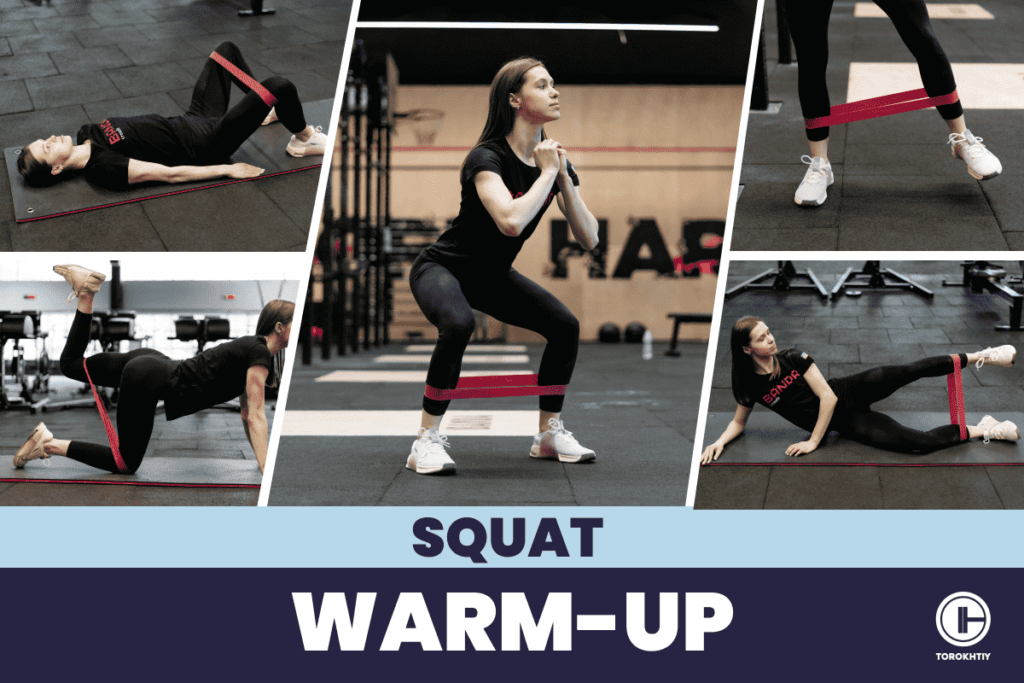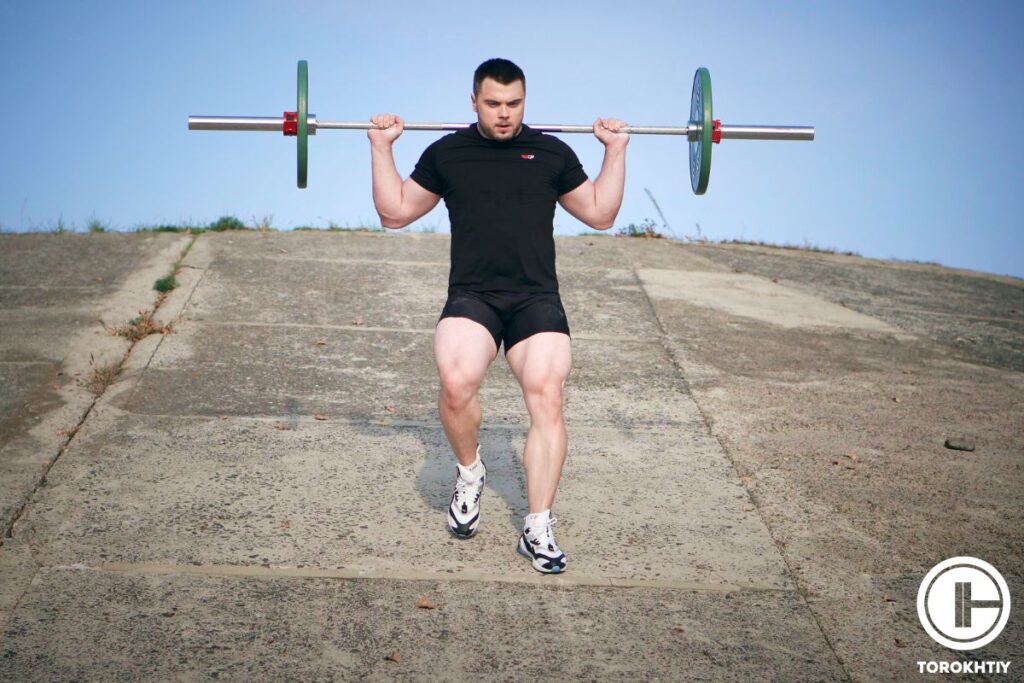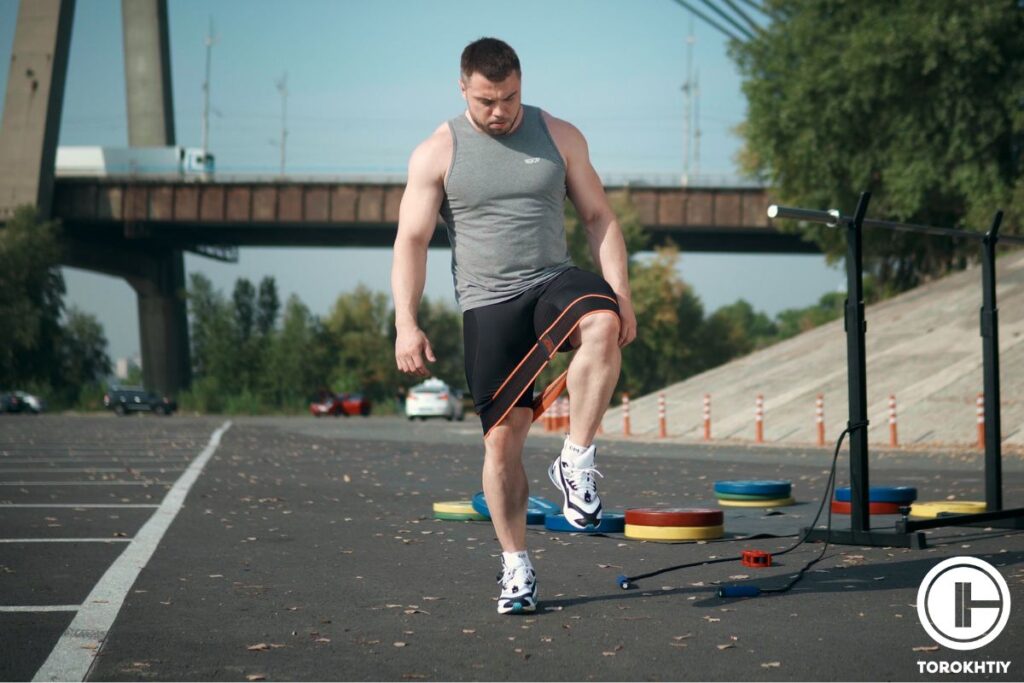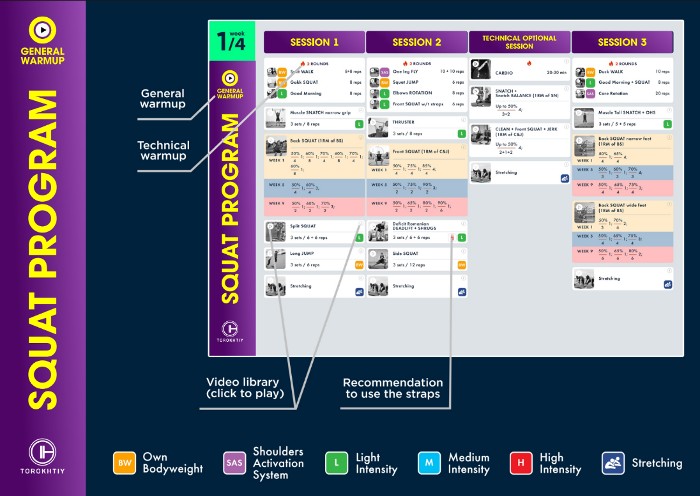Best Squat Warm-Up For Peak Performance
Author:
Reviewed by:
(21 years of Oly Lifting experience)
Unlock your full potential by engaging with our experts and community! Have questions about your fitness journey or looking for expert advice on weightlifting techniques? Don’t hesitate — leave a comment below and Sergii Putsov will provide a personalized answer and insights to help you reach your goals.
Torokhtiy is reader-supported. Some links are affiliate links, and we may earn a commission at no extra cost to you. See our disclosure page for details.
Embarking on any strength training, particularly squats without the proper squat warm-up is like driving a car without oiling the engine. It’s a pivotal start to any leg day: prepare tendons, muscles and joints for the session ahead.
Warming up, increases blood flow, enhances flexibility and reduces the risk of injury, ensuring that your squad performance is both safe and efficient.
A squat warm-up is a series of exercises designed to prepare the body for squats by increasing core temperature, activating muscles and enhancing joint mobility. This routine minimizes injury risk and primes the neuromuscular system for effective focused squat sessions.

A solid warm-up primes the neuromuscular system for the complex movement patterns involved in squats and activates the core which is essential for maintaining proper posture balance throughout the movement.
Moreover, taking time to warm up before squats not only prepares your body physically, but also gears up your mind, setting in the tone for an effective and focused session.
In this article, we will explore the integral components that constitute an effective squat warm-up routine, paving the way for a squat that’s both productive and powerful. By integrating a sequence of targeted stretches and drills, you will establish a foundation for long-term progress and peak performance in your squatting journey.
Basics of a Squat Warm-up
A well-rounded squat warm-up starts with increasing your core temperature, and ends with specific exercises that mirror the squatting motions. This process is essential to activate key muscle groups, lubricate the joints, and prepare your body for the load to come.
Here’s how to warm up for squats:
1. Light Cardio
Begin with five minutes of light cardio, such as jogging, or jumping jacks, followed by dynamic movements that specifically target the hips, knees and ankle.

2. Mimic Movements
Next integrate movements that mimic the squat. Bodyweight squats are the foundation. Perform them with the focus on form and full ROM. Add walking lunges to engage the hip flexors and stretch the muscles dynamically. Continue with some leg swings and hip circles to enhance joint mobility, ensuring these movements are controlled and progressive in range.
The physiological benefits of these warm-up steps are multifold. They increase blood flow to the muscles, activate the nervous system and elevate the muscle`s temperature, making them more elastic.

This state not only improves performance by enabling more powerful and sustained muscle contractions, but also significantly reduces the risk of sprains and strains. Additionally, the pre-squat warm-up enhances proprioception – the body`s awareness of positioning and movement, which is crucial for execution squats with solid technique.
Dedicating time to a squat specific warm-up routine, not only sets the stage for a safer workout, but also contributes to better squat performance, paving the way for greater progression and strength gains in your fitness journey.
Follow us!

Free!
Get a 2-week Weightlifting Program as a bonus for the subscription to kickstart your training plan!

Free!
Dynamic Stretches for Squats
Dynamic stretches are vital for engaging the muscles you will use during squats. Unlike static stretching which involves holding a position, dynamic stretches for squats include controlled movements that mimic the squat exercise, enhancing the flexibility and increasing blood flow necessary for deep squats.
This kind of stretching the ankle, hips and knees for the stress of squatting thereby reducing the risk of injury.
1. Leg Swings
For the knees and hips, leg swings are excellent. Stand side-on to a wall, swing the outside leg forward and back like a pendulum, gradually increasing the amplitude. Side to side leg swings can also warm up the adductors and abductors crucial for knee stability.
2. Walking Lunges Variations
Walking lunges open the hip flexors and activate the glutes while “frankenstein walks” – kicking your leg, straight up to touch your opposite hand, stretch the hamstrings and warm up the hip joints.
3. Ankle and Calf Activation
Incorporating ankle roles and calf raises as part of the knee warm-up before squats helps to prevent strain in these areas, which are pivotal for a solid and stable squat foundation. These dynamic movements, primed the muscles and joints increase ROM and prepare your body for the load of weight-bearing exercises.
Dynamic stretching before squats also prepares the nervous system for activity, ensuring that your brain and muscles are working like a team. This neural readiness is key to maintaining coordination and balance during squats, resulting in better effectiveness and performance of your workout.
By incorporating these dynamic stretches, you are setting the stage for a squat session that is both efficient and safe.
Squat-Specific Warm-Up Exercises
The effectiveness of your squat session largely depends on the specific warm-up exercises you perform beforehand. The best squat warm-up routine involves a combination of movements that not only elevate the heart rate, but also target the squats, specific joints and muscle groups.
1. Air Squats
Begin with air squats to acclimate your body to movement patterns. Stand with feet shoulder-width apart, drive your hips back and down, keeping the chest up and knees in one line with toes. Perform 10-15 reps to lubricate the hip joints and “wake up” the muscle memory for the movement.
2. Goblet Squat
Progress to goblet squat using a light dumbbell or kettlebell. Hold the weight close to your chest, squat down and hold the bottom position for 3-5 seconds to increase ankle mobility and reinforce depth control. Do 8-10 reps to warm up your core and glutes further.
3. Inchworms
Incorporate inchworms for full body activation. Stand tall, reach to the floor with straight legs, walk your hands forward into a plank, then walk your feet towards your hands, keeping legs straight. Repeat for 5-6 reps to stretch the hamstrings and activate shoulders.
4. Pause Squats
Include a few sets of paused squats. Squat down, pause at the bottom for a full two seconds, then explode up. This exercise increases time under attention, improving strength and control through the entire range of motion.
5. Jump Squats
Finally, add some jumping squats. Perform basic squat, then leap up explosively and land softly. These plyometric moves fire up the fast-twitch muscle fibers preparing your body for the power needed in weighted squats.
These squat warm-up exercises prepare the body for the load ahead, ensuring that when you step under the bar, your joints are nimble, your muscles are engaged and you are ready to squat with precision and power.
🔻GET A FREE PROGRAM DEMO: 12 Week Squat Program by Oleksiy Torokhtiy

Do you want to double your squat strength? In just 12 weeks, you’ll be able to boost your squat results.
Enter your details and get a free demo (1 free week) of the squat program straight into your inbox.
Building Squat Warm-Up Routine
Creating an effective squat warm-up routine is like crafting a personalized game plan that gets you in the best condition to hit the squat rack. The goal is to mobilize the muscles and joints while also stimulating the nervous system to support the complex squat movement.
1. Foam Rolling
Start with foam rolling for about five minutes to work on any tight spots, especially around the thighs, hips, and calves. This helps in trigger points pain relief, and increasing blood flow, setting the stage for enhanced mobility.
2. Dynamic Stretches
Then shift to dynamic stretches, such as leg swings and lunges to actively stretch the tendons and muscles.
This is followed by a series of mobility drills, targeting the thoracic spine ankles and hips, which play critical roles in achieving proper squad, depth, and form. Spend around five minutes on exercises like hip, openers circles and gentle, spinal twists.
3. Activation Exercises
Next, include activation exercises like bird-dogs and glute bridges to wake up the primary muscles used in squatting. Perform 2-3 sets up to 12-20 reps. This is crucial for ensuring all muscles are engaged and ready to support the squat load.
4. Mimic Movements
The last part – transition into movement rehearsal with air squats, goblet squats, and walk lunges. Gradually increase the intensity and depth with each repetition preparing the body for the weight.
By systematically progressing, through these stages of your squat mobility warm-up, you lay down the groundwork for a squat session that is not only productive in terms of strength gains, but also protective against the risk of injury.
A well-constructed warm up routine is the underpinning of excellence in squatting, allowing for a full ROM and reinforcing the proper mechanics throughout the workout.
5. Advanced Warm-up Strategies
For experienced athletes an advanced squat warm-up can be a game-changer, offering enhanced activation and mobility to tackle more significant weights. The best squat warm up for seasoned lifters incorporates not just basic movements, but also complex drills that simulate the squat pattern while challenging control and stability.
6. Plyometric Exercises
Plyometric exercises such as box jumps and jump squats can be introduced after the basic warm map to prime the central nervous system for explosive movements. Around 3 sets of 5 reps can effectively activate fast-twitch muscle fibers crucial for powerful squatting.
7. Resistance Bands
Resistance bands are excellent tools for adding load to mobility to work. Lateral band walks activate the glutes, while monster walks target the entire kinetic chain involved in squatting. Perform 2 sets of 10 reps in each direction to ensure the thighs and hips are fully engaged.
8. Mobility Work
To integrate mobility to work, consider incorporating overhead squats with PVC pipe, or an unloaded bar to enhance shoulder stability and mobility in the thoracic spine, vital for a strong position during back and front squats. Similarly, deep squats holds with counterbalance, can improve ankle and hip mobility, which are essential for achieving depth safely and effectively.
9. Unilateral Exercises
Incorporate unilateral exercises, such as single-leg Romanian deadlifts or squats for balance, proprioception and better muscle activation, which translate to better body awareness during heavy squats. This can also highlight and correct imbalances between the legs.
Check this example of squat warm-up routine than you can use before your squatting sessions:
- Foam Rolling – 5-7 min (hips, calves, feet and back as well)
- Leg swings – 10-12 reps per leg
- Hip Openers – 10-12 reps per side
- Spinal Twists – 6-8 reps per side
- Bird-Dogs – 2 sets 20 reps
- Air Squats – 2 sets 8-12 reps
- Walk Lunges – 2 sets 10-12 reps
- Lateral Band Walks – 2 sets 6-8 reps per side
- Box Jumps – 2 sets 5 reps
These advanced techniques elevate the warm-up form a simple routine to a comprehensive strategy that not only prepares the body for the demands of heavy, squatting, but also contributes to injury prevention and overall athletic development.
Integrating these elements can make a substantial difference in long-term progress as an athlete and effectiveness of your squats.
Conclusion
To recap – an effective squat warm-up enhances performance, prevents injury and is essential for a long-term strength development. From basic dynamic stretches to advanced mobility drills, the key is warm-up that is as comprehensive as your squatting goals.
Consistency in your warm-up routine can vastly improve your squat depth, form and overall lifting experience. It’s not just about the warm-up you do today, it’s about building a foundation for every squat session to come.
Share your warm-up experiences in the comments, and let’s learn from each other to elevate our fitness journeys.
Also Read:
- 8 Shoulder Warm-up Exercises and Their Benefits
- Best Snatch Warm Up Routine: Ultimate Guide
- How To Warm Up Before Lifting: Elevate Your Lifts
- My Top 6 Back Squat Exercises
- Squat Pyramid: What Is It & How To Create Your Own
- 8 Squat Cues For Perfect Form And Strength
- 12 Exercises To Improve Squat Strength & Form
- Arm Exercises for Weightlifting: Are They Important?
Reference:
- Rottier TD, Allen SJ. The influence of swing leg technique on maximum running speed. J Biomech. 2021 Sep 20;126:110640. doi: 10.1016/j.jbiomech.2021.110640. Epub 2021 Jul 19. PMID: 34365273.
- Muyor JM, Martín-Fuentes I, Rodríguez-Ridao D, Antequera-Vique JA. Electromyographic activity in the gluteus medius, gluteus maximus, biceps femoris, vastus lateralis, vastus medialis and rectus femoris during the Monopodal Squat, Forward Lunge and Lateral Step-Up exercises. PLoS One. 2020 Apr 1;15(4):e0230841. doi: 10.1371/journal.pone.0230841. PMID: 32236133; PMCID: PMC7112217.
- Collins KS, Klawitter LA, Waldera RW, Mahoney SJ, Christensen BK. Differences in Muscle Activity and Kinetics Between the Goblet Squat and Landmine Squat in Men and Women. J Strength Cond Res. 2021 Oct 1;35(10):2661-2668. doi: 10.1519/JSC.0000000000004094. PMID: 34341315.
- Wiewelhove T, Döweling A, Schneider C, Hottenrott L, Meyer T, Kellmann M, Pfeiffer M, Ferrauti A. A Meta-Analysis of the Effects of Foam Rolling on Performance and Recovery. Front Physiol. 2019 Apr 9;10:376. doi: 10.3389/fphys.2019.00376. PMID: 31024339; PMCID: PMC6465761.
- Eliassen W, Saeterbakken AH, van den Tillaar R. COMPARISON OF BILATERAL AND UNILATERAL SQUAT EXERCISES ON BARBELL KINEMATICS AND MUSCLE ACTIVATION. Int J Sports Phys Ther. 2018 Aug;13(5):871-881. PMID: 30276019; PMCID: PMC6159498.
- Photos made by Torokhtiy Media Team.
Why Trust Us?
With over 20 years in Olympic weightlifting, strength training, nutrition coaching, and general fitness our team does its best to provide the audience with ultimate support and meet the needs and requirements of advanced athletes and professional lifters, as well as people who strive to open new opportunities and develop their physical capabilities with us.
By trusting the recommendations of our certified experts in coaching, nutrition, and sports training programming, as well as scientific consultants, and physiotherapists, we provide you with thorough, well-considered, and scientifically proven content. All the information given in the articles concerning workout programming, separate exercises, and athletic performance, in general, is based on verified data.
The product testing process is described in more detail here.
Author: Sergii Putsov
Head of Sport Science, PhD
Best Results: Snatch – 165 kg,
C&J – 200 kg
Sergii Putsov, Ph.D., is a former professional weightlifter and National team member, achieving multiple medals in the 94 kg weight category at national competitions. With a Master’s degree in “Olympic & Professional Sport Training” and a Sport Science Ph.D. from the International Olympic Academy, Greece, Sergii now leads as the Head of Sport Science. He specializes in designing training programs, writing insightful blog articles, providing live commentary at international weightlifting events, and conducting educational seminars worldwide alongside Olympic weightlifting expert Oleksiy Torokhtiy.
Reviewed by: Oleksiy Torokhtiy
Olympic Weightlifting Champion, PhD in Sport Science
Best Results: Snatch – 200 kg,
C&J – 240 kg
Oleksiy Torokhtiy is a professional athlete boasting 20 years of experience in Olympic weightlifting. With multiple European and World titles under his belt, he has showcased his prowess in two Olympic Games (Beijing 2008 and London 2012). Upon concluding his illustrious career, Oleksiy dedicated himself to coaching. By 2022, he had conducted over 200 weightlifting seminars worldwide. He is the visionary behind an international sportswear and accessories brand known for its motto, “Warm Body Cold Mind.” Additionally, he is an esteemed author and the creator of a series of training programs and eBooks.




Still have questions after reading our article? Unlock your full potential by engaging with our experts and community! Don’t hesitate — leave a comment below and Sergii Putsov will provide a personalized answer and insights to help you reach your goals.